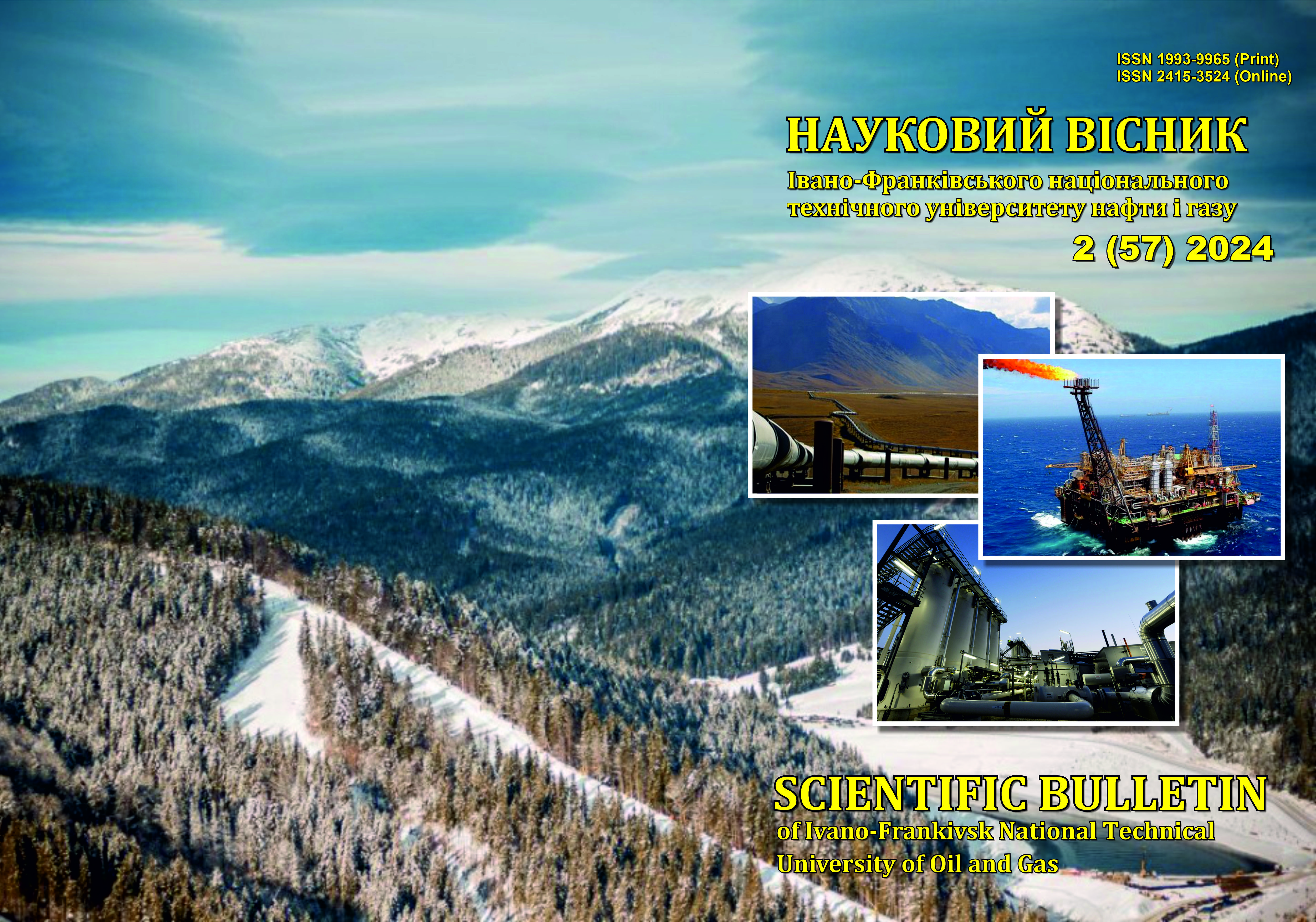MODELING OF ADHESIVE-PRESS CONNECTION OF HOLLOW FIBERGLASS SUCKER RODS
DOI:
https://doi.org/10.31471/1993-9965-2024-2(57)-50-57Keywords:
polymer composite material, strength, stress, interference fitAbstract
Hollow sucker rods made of polymer composite materials (PCM) have high fatigue strength, but require improvement and ensuring the strength of the connection of the composite body with a steel nipple. The design of such connections is complicated by the fact that the PCM body has orthotropic characteristics of elasticity and strength and low interlayer strength. Morphological analysis has shown that a promising direction for improving such connections is the combination of adhesive-wedge, press and threaded connection methods in one design. This allows to increase strength, improve manufacturability, and prevent the penetration of the medium into the contact zone. The annular hole of the steel nipple with a screw thread is filled with glue and a smooth rod is screwed into it to form a tight fit. The polymerized glue forms a system of wedges that provide additional strength. A finite element axisymmetric model of such a connection has been developed with simulation of contact, ductility of the nipple material and orthotropy of the body material. Two simulation steps are performed. In the first, tension and polymerization of wedges are simulated. In the second step, the connection is gradually loaded with a tensile force, which is simulated by axial movement of the body end. The moment of failure of the connection is determined by the maximum value of the stress in the body. The simulation confirmed the effectiveness of the proposed design. The considered variant withstands tensile stresses up to 709 MPa, and the equivalent stresses in the body after tension formation are close to 500 MPa. The parametric model and macro for it can be used to study and optimize the parameters of such a connection for different types of PCM (fiberglass, carbon fiber, etc.). Increasing the tension and length of the contact zone does not solve the problem of stress concentration. Optimization of other geometric parameters is necessary. Promising solutions may include the creation of an additional screw thread on the opposite contact surface, additional crimping with dies, special surface treatment, the use of a variable hole diameter, pitch and other screw thread parameters along the axis.
Downloads
References
Kopei B.V., Kuzmin O.O., Onyshchuk S.Yu. Equipment for the prevention of deposits of asphalt resinous substances, paraffin and sand: monograph. Series "Oil and gas equipment", Vol. 3. Ivano-Frankivsk: IFNTUNG, 2014. 216 p. [in Ukrainian]
Kuzmin O. O. Improvement of well equipment for the prevention of deposits of sand, paraffin and resins: author's abstract of dissertation candidate of technical sciences: 05.05.12. IFNTUNG. Ivano-Frankivsk, 2012. 18 p. [in Ukrainian]
Gibbs S. G. Application of Fiberglass Sucker Rods. SPE Production Engineering. SPE, Nabla Corp., May 1991. P. 147-153.
Sucker rods and pipes made of polymer composites: design, calculation, testing / Kopei B.V., Maksymuk O.V., Shcherbyna N.M., Rozgonyuk V.V., Kopei V.B. Lviv : IPPMM, 2003. 352 p. [in Ukrainian]
Kopei V.B., Kopei B.V. Design and strength of columns and joints of sucker rods made of polymer composites: Monograph. Series "Oil and gas equipment": in 12 vol. Under the general editorship of B.V. Kopei. Volume 12. Ivano-Frankivsk : IFNTUNG, 2021. 314 p. [in Ukrainian]
Seidlitz H., Ulke-Winter L., Ost L., Kuke F. Material and load path appropriate joining techniques for FRP/metal hybrid structures. Welding - Materials, Fabrication Processes, and Industry 5.0. Intech Open. 2023. https://doi.org/10.5772/intechopen.1002239
Hentinen M., Hildebrand M., Visuri M. Adhesively bonded joints between FRP sandwich and metal: Different concepts and their strength behaviour. VTT Tiedotteita - Meddelanden - Research Notes, no. 1862, Espoo : VTT Technical Research Centre of Finland. 1997. 44 p. URL: https://publications.vtt.fi/pdf/tiedotteet/1997/T1862.pdf
Pat. US20120141194A1, Int. Cl. E21B 17/04, B32B 38/04. Sucker Rod End Fittings and Method of Using Same / Russell P. Rutledge, SR.; Russell P. Rutledge, JR.; Ryan B. Rutledge. Filed: Feb. 10, 2012; Pub. Date: Jun. 7, 2012. 10 p.
Zhang J., Liu Y., Cheng L., Kang D., Gao R., Qin Y., Mei Z., Zhang M., Yu M., Sun Z. Design and Performance Study of Carbon Fiber-Reinforced Polymer Connection Structures with Surface Treatment on Aluminum Alloy (6061). Coatings. 2024. Vol. 14, Iss. 7. P. 785. https://doi.org/10.3390/coatings14070785
Lambiase F., Scipioni S.I., Lee C-J., Ko D-C., Liu F. A State-of-the-Art Review on Advanced Joining Processes for Metal-Composite and Metal-Polymer Hybrid Structures. Materials. 2021. Vol. 14, Iss. 8. P. 1890. https://doi.org/10.3390/ma14081890
Kopei V. Fiberglass-Sucker-Rod-Connection. URL: https://github.com/vkopey/Fiberglass-Sucker-Rod-Connection/tree/master/2023
Downloads
Published
How to Cite
Issue
Section
License
Авторські права....


1.png)

















